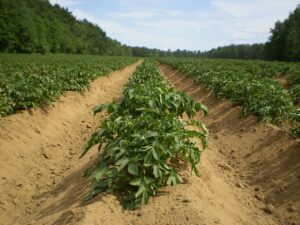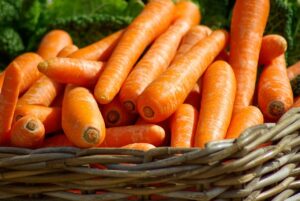Explore Our In-Depth Organic Farming Guide
- Master the Fundamental Principles of Organic Farming
- Discover the Key Benefits of Embracing Organic Farming
- Analyze the Limitations of Organic Farming Practices
- Uncover the Essential Features and Importance of Organic Farming
- Comprehensively Define Organic Farming: Characteristics, Advantages, and Core Values
- Understand the Health and Environmental Benefits of Supporting Organic Farming
- Learn About the Soil Association’s Perspective on Organic Farming
- See How Simone Thomas Wellness Promotes Organic Farming Initiatives
- Enhance Soil Conservation and Management with Organic Farming Techniques
- Explore Recent Research on the Environmental Effects of Organic Farming
- Evaluate the Financial Considerations of Organic Products
- Gain a Comprehensive Understanding of the Pros and Cons of Organic Farming
Master the Fundamental Principles of Organic Farming
Organic farming represents a holistic approach to agriculture, focusing on natural methods for growing crops, raising livestock, and producing poultry. This sustainable agricultural method employs a variety of techniques such as green manure, composting, biological pest control, and crop rotation to boost productivity while safeguarding the environment. By enhancing the natural cycling of resources, organic farming works to maintain biodiversity, promoting an ecological balance crucial for sustainable food production. Key strategies employed in this practice include the use of cover crops, applying animal manure, and implementing crop rotation to disrupt pest and disease cycles, improve soil fertility, and maximize biological activity in the soil. These practices collectively create a vigorous ecosystem that supports healthy farming.
The core tenet of organic farming is its emphasis on managing ecosystems to enhance soil health while minimizing reliance on synthetic inputs. This involves the careful practice of plant breeding to improve resilience without genetic modification, implementing targeted pest control measures that do not involve synthetic pesticides, and utilizing natural fertilizers instead of chemical alternatives. Innovative practices, such as the no-till revolution, demonstrate the accessibility and effectiveness of these methods for both gardeners and farmers. Such strategies ensure environmental and economic benefits while avoiding the need for expensive equipment, allowing for a more sustainable approach to agriculture.
The surge in organic farming’s popularity can be attributed to rising concerns regarding pesticide residues and the potential risks associated with genetically modified organisms (GMOs). Effective marketing strategies adopted by organic advocates have substantially influenced consumer behavior, prompting many farmers to transition to organic methods for the potential of higher profits. However, this shift has also led to instances of fraudulent labeling, where conventional farmers inaccurately label their products as organic. The ongoing challenge is to develop reliable testing methods capable of distinguishing organically grown crops from those treated with synthetic fertilizers, as there may be minimal differences in the fundamental biological characteristics of these plants.
Discover the Key Benefits of Embracing Organic Farming
As the global population is expected to increase by billions in the next century, the imperative to sustainably feed this growing population becomes increasingly urgent. Current agricultural practices, particularly conventional industrial methods, are putting immense pressure on our planet’s limited land resources, which are becoming increasingly degraded due to extensive farming practices. A report from National Geographic News reveals that food production currently occupies nearly half of the Earth’s land area, threatening the depletion of the remaining fertile zones. To tackle this pressing issue, it is vital to thoroughly assess both the strengths and weaknesses of modern industrial agriculture and organic farming practices.
A fundamental principle of organic farming is the strict prohibition of synthetic chemical fertilizers, antibiotics, herbicides, and pesticides. The primary goal of organic practices is to achieve agricultural outputs—including fibers, grains, vegetables, fruits, and livestock—through the most natural and sustainable methods available. Organic farming excels in protecting our water and soil resources, maintaining ecological balance, and efficiently utilizing renewable resources. Yet, acknowledging the potential downsides is equally important. Below, we will explore the various advantages and disadvantages associated with organic farming practices, offering a well-rounded perspective on this critical agricultural method.
As your understanding of organic farming deepens, you may find yourself contemplating its significance and future implications. The growing global population necessitates a transition from conventional farming methods, which heavily depend on chemical inputs, to more sustainable practices. The harmful effects of chemical fertilizers and pesticides on our soil, air, and water quality underscore the urgent need for organic farming practices that prioritize ecological health and the production of non-toxic food options.
Despite currently occupying only about 1% of the world’s agricultural land, organic farming presents an untapped opportunity to tackle one of humanity’s greatest challenges: producing enough food for a projected population of 10 billion by 2050 without causing extensive deforestation or environmental degradation. This conclusion is supported by a study led by my PhD student, Jonathan Wachter, which evaluated numerous scientific studies comparing the long-term sustainability of both organic and conventional agriculture. The published research, titled “Organic agriculture in the 21st century,” employed the four main sustainability criteria established by the National Academy of Sciences: productivity, economic viability, environmental soundness, and social justice.
Analyze the Limitations of Organic Farming Practices
While organic farming offers numerous benefits, it also presents certain challenges. Research conducted by CNN suggests that organic crop yields may be significantly lower—by as much as 25%—in comparison to their conventionally grown counterparts. This variation in yield can be influenced by several factors, including seasonal changes and the types of crops grown; however, the inherent challenges associated with organic cultivation can lead to slower growth rates. Additionally, the methodologies employed in organic farming often result in higher consumer prices than those linked to conventionally grown food products.
The rising consumer demand for organic products has transformed the food market landscape. Once considered a niche market for the affluent or environmentally conscious, organic food has gained widespread acceptance across various demographics. Organic farming practices, which avoid the use of artificial fertilizers and pesticides, embrace more traditional methods of pest and nutrient management, such as crop rotation, natural barriers, and ecological pest control measures.
Over the last two decades, the organic agriculture sector has witnessed remarkable growth, with sales of organic foods and beverages soaring from $1 billion in 1990 to an astounding $26.7 billion by 2010. This growth has been fueled by average annual increases ranging from 12% to 21% (OTA, 2011). Notably, in 2005, all 50 states in the U.S. reported the presence of certified organic farms, encompassing over 4 million acres (USDA-ers, 2008). However, with nearly 70% of American consumers now purchasing organic products (Hartman Group, 2008), many organic farmers are struggling to keep pace with the rapid expansion of their market, leading to a supply-demand gap.
The increasing population in regions like Florida is leading to development pressures that negatively impact natural resources and contribute to environmental degradation. Embracing organic agriculture can alleviate some of this environmental strain by promoting natural food production methods. By limiting the use of pesticides and herbicides, organic farming fosters diverse ecosystems that include a variety of plants, insects, and wildlife (McIlwain 2004). Furthermore, organic practices are generally less energy-intensive and generate minimal waste compared to conventional farming methods. A study conducted by Washington State University indicated that growing organic apples is approximately 7% more energy-efficient than conventional apple farming (McIlwain 2004).
Uncover the Essential Features and Importance of Organic Farming
Organic farming is defined by its unwavering commitment to soil health and sustainability, ensuring that agricultural practices do not degrade the land or contribute to desertification. This restorative approach prioritizes environmental stewardship and aims to maintain the health of our ecosystems for generations to come. Sustainability is at the very heart of organic farming’s philosophy!
To keep readers updated on the latest developments in organic farming, Organic Farming Magazine stands out as the UK’s premier publication, released up to three times a year by the Soil Association. Each issue provides valuable insights into news, policy changes, and market trends, along with in-depth technical articles and reports showcasing the latest field trials and research in organic farming practices. The topics covered span livestock management, horticulture, and various agricultural disciplines.
A significant component of organic farming is the adoption of organic pest control methods, which completely avoid chemical pesticides. This practice not only preserves the integrity of the soil but also promotes a healthier ecosystem. When implemented effectively, organic pest control can sustain healthy crops for generations, making it essential for anyone interested in organic farming to understand the principles behind how it operates.
The demand for organic fruits and vegetables is rapidly increasing at farmers’ markets, driven by a growing public awareness of health and nutrition. Establishing an orchard requires careful planning and attention to detail, and this resource offers vital information on designing optimal planting strategies while fostering a deep connection with nature. It also discusses sustainable farming techniques alongside advanced methods such as grafting different tree varieties. Furthermore, it outlines the best species to cultivate, what to avoid, and essential insights into biodiversity and pollination practices that support organic farming.
Comprehensively Define Organic Farming: Characteristics, Advantages, and Core Values
While modern agricultural practices offer certain benefits, the misuse of pesticides can lead to toxic effects on plants, animals, and the environment. Organic farming presents a sustainable alternative that protects the health of our ecosystems. In the United States, nearly 44% of agricultural imports consist of fruits, vegetables, wine, hops, and various specialty crops. This reliance on imports can create ethical dilemmas and social issues within farming communities, as some individuals may attempt to exploit labor forces to cultivate crops on their behalf.
Understand the Health and Environmental Benefits of Supporting Organic Farming
Embracing organic farming benefits not only the soil and plants but also the broader ecosystem, which includes animals and humans. Organic farming practices, as described by Foam Organics International, provide a multitude of advantages.
However, it is important to recognize that organic food generally carries a higher price compared to non-organic options. The advantages of consuming organic food extend beyond taste and nutrition; they may also decrease your exposure to antibiotic-resistant bacteria. Additionally, organic products can be prepared and frozen without significantly compromising their nutrient density. Although organic food may not always be the most financially accessible choice, its production methods foster health and sustainability, making it a worthy investment for conscious consumers.
Currently, organic farming accounts for only about 1% of the global agricultural landscape, showcasing a significant potential for growth. This limited presence presents challenges not only for food quality but also for the preservation of our land and planet. Organic farming practices play a crucial role in maintaining the soil’s organic composition, helping to mitigate the ongoing destruction of the ozone layer caused by pesticides and emissions from various agricultural machinery.
Organic milk serves as a prime illustration of the benefits associated with organic farming. Many individuals who are lactose intolerant may choose soy milk as an alternative; however, organic options frequently offer superior health benefits. Taste preferences also influence consumer choices, with many finding organically produced food to be more flavorful and satisfying. It is worth noting that the USDA mandates that at least 70% of ingredients in products labeled as organic must originate from organic sources. Concerns have emerged regarding synthetic additives in the food supply, as they have been linked to serious health issues, including infertility, certain cancers, Parkinson’s disease, and endocrine and autoimmune disorders.
Learn About the Soil Association’s Perspective on Organic Farming
The environmental repercussions of synthetic fertilizers cannot be overstated; their runoff into waterways presents significant threats to aquatic ecosystems and water quality. In contrast, organic fertilizers do not leach from the soil as readily and positively contribute to soil structure. The Organic Trade Association reports that organic fertilizers can enhance biodiversity by up to 30% compared to their synthetic counterparts.
The Organic Farming Digest, produced between 1946 and 1954, was the first publication dedicated to organic farming, created by an agricultural association based in Sydney. This quarterly magazine featured contributions from both Australian authors and international experts, covering a broad range of topics related to organic farming and gardening. The publication later became the official magazine of the Living Soil Association of Tasmania, with its final issue released in December 1954.
According to the USDA Organic Agriculture Study Team, organic farming is defined as a production system that primarily avoids or eliminates the use of synthetic fertilizers, pesticides, growth regulators, and feed additives. Instead, it relies on techniques such as crop rotation, biological pest control, animal manure, crop residues, and mechanical tillage to enhance soil productivity and manage pests. Organic farmers strive to work in harmony with nature, fostering biodiversity to create a balanced ecosystem rather than depending on artificial inputs.
The U.S. Department of Agriculture describes organic farming as an agricultural system that responds to site-specific conditions and integrates cultural, biological, and mechanical practices to promote resource cycling, support ecological balance, and maintain biodiversity. Essentially, organic agriculture prioritizes natural methods over synthetic ones to cultivate healthy crops and nurture healthy soils.
Enhance Soil Conservation and Management with Organic Farming Techniques
The quest for a sustainable and green environment has become a global priority. Research indicates that organic agriculture can significantly contribute to this goal. Long-term studies demonstrate that organic farming not only promotes ecological harmony and biodiversity but also supports biological cycles essential for environmental sustainability. The fundamental objectives of organic farming encompass effective soil management and conservation, nutrient cycling, ecological balance, and the preservation of biodiversity. These practices are instrumental in mitigating the impacts of global climate change while positively contributing to environmental conservation efforts.
As previously mentioned, pest control within organic farming heavily relies on crop management and biological control strategies. The prohibition of synthetic fertilizers and pesticides fosters the preservation of natural predators and beneficial insects, enhancing the overall health of the ecosystem. This elimination of harmful pesticides increases the diversity of crop pollinators and reduces pesticide residues in food products. Organic farms, managed with an emphasis on biodiversity, also create environments where microorganisms can thrive, leading to improved soil fertility and greater ecosystem sustainability. Diverse cropping systems and the cultivation of hedgerows provide habitats for beneficial insects and wildlife, further enhancing biodiversity within organic farming systems.
Explore Recent Research on the Environmental Effects of Organic Farming
1 January, 2021
Research has shown that genetically modified organisms (GMOs) can adversely affect local biodiversity. While industrial agriculture provides consumers with a wider variety of food options and promotes balanced diets, the introduction of GMOs has sparked considerable controversy among consumers. Understanding the implications of GMOs, alongside the distinctions between GMO, non-GMO, and organic crops, is vital for making informed consumer choices and agricultural practices.
Evaluate the Financial Considerations of Organic Products
The price of organic food typically surpasses that of conventional produce, often by significant margins. The organic food market lacks the well-defined pricing structures found in other agricultural sectors, which can create challenges for specialty farmers competing in the marketplace. Many communities have responded by establishing food cooperatives with local farmers, allowing consumers to prepay for their organic produce, which they can collect at the end of the growing season.
There is no denying that organic products often come at a premium—the costs of organic items can be 50% to 300% higher than conventional alternatives. The labor-intensive nature of organic farming contributes to these price discrepancies. Despite this, organic products yield significantly higher returns on investment for retailers and farmers alike. Consumers are increasingly willing to pay more for organically produced items, although the supply remains limited.
Additionally, organic food tends to have a shorter shelf life than conventional products. For farmers, producing crops for the organic market involves increased physical demands. While conventional farming focuses on maximizing yields of specific crops, organic farming strategies require minimizing off-farm inputs and external factors that may impact growth. Nevertheless, the environmentally friendly practices associated with organic farming contribute positively to ecological balance and sustainability.
The development of organic farming practices by “Kusto Agro” illustrates a growing commitment to expanding the area of cultivated land and enhancing crop diversity. In Europe, organic products have gained popularity among consumers, despite their higher costs. This trend represents a profitable business opportunity as the global market for organic products continues to grow at an annual rate of 10-15%. To compete internationally, however, obtaining appropriate certification is crucial.
While organic farming has numerous advantages, it is essential to recognize its limitations and challenges. We will explore the most significant pros and cons of organic farming practices in the following section.

Gain a Comprehensive Understanding of the Pros and Cons of Organic Farming
Written by Behind the Plough | Feb 13, 2019, | Agricultural Resources, Organic Farming
The ongoing debate surrounding conventional versus organic farming continues to captivate public interest. It is crucial to acknowledge that both farming methods possess unique advantages and disadvantages. Ultimately, the decision regarding which practices to adopt rests with individual farmers, who must consider their specific circumstances and objectives.
While organic food typically has a shorter shelf life compared to its conventional counterparts, producing crops for the market can be physically demanding for farmers. Conventional agricultural methods may prioritize growing specific, high-yield crops, while organic farming necessitates a more integrated approach that minimizes reliance on external inputs. Organic farming practices are fundamentally more environmentally friendly; however, they also present their own set of challenges, particularly in maintaining soil quality and ecological balance.
The management of weeds, pests, and plant diseases in organic farming requires a comprehensive and integrated approach. This systems-based strategy involves utilizing a variety of tools and techniques rather than relying solely on one method, such as pesticide application. This approach, termed Integrated Pest Management (IPM), enhances the effectiveness of organic-approved pesticides while potentially reducing overall usage. IPM is not a novel concept; integrated strategies have been utilized for centuries, albeit without a standardized term.
At its core, organic farming embodies the principle of interconnectedness among soil, plants, animals, and humans. Its role in sustainable agricultural practices is to enhance the health of both the environment and the food system, beginning at the microbial level in the soil and extending up the food chain. Organic farming emphasizes the responsible management of ecological resources to ensure fair production and consumption practices for all living beings. The guiding principles of precaution, care, and responsibility are crucial for establishing a healthy, safe, and environmentally sound agricultural economy for future generations.
Organic agriculture is characterized by its prohibition of synthetic agricultural chemicals, including fertilizers, pesticides, herbicides




5 Responses
This guide offers such a thorough exploration of organic farming! One aspect that stands out to me is the emphasis on soil health, which is often overlooked in conventional practices. I’ve been experimenting with a small organic garden, and I’ve noticed how much healthier and more vibrant the plants are compared to past attempts with chemical fertilizers.
This guide does a fantastic job of outlining the intricacies of organic farming, particularly its holistic approach and the benefits it brings not just to the environment, but also to our health. I find it fascinating that while we often talk about the benefits, the limitations of organic farming also merit discussion. For instance, how does one balance the desire for environmentally friendly practices with the increasing demand for food supplies as our global population grows?
You’ve raised a crucial point that often flies under the radar in conversations about organic farming. The balance between sustainable practices and the growing demand for food is a real challenge we’re facing today. It’s fascinating to think about how we can approach this from multiple angles.
You make a really good point about the balancing act between organic farming’s benefits and the growing demand for food. It’s definitely a tricky situation. One thing to consider is that organic farming isn’t just about growing food without synthetic pesticides or fertilizers; it can also involve using innovative practices like permaculture or agroecology that help maximize yields sustainably.
The exploration of organic farming practices is incredibly timely, especially considering the growing conscious consumer movement. I appreciate the thoroughness of your guide and the balance you strike between highlighting the benefits and acknowledging the limitations of organic farming.